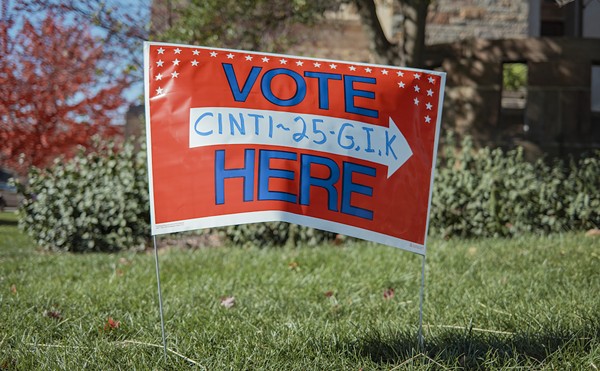|
Liliana Duque Piñeiro looks out the window at the University of Cincinnati's College of Design, Art, Architecture and Planning (DAAP). From the 840 Gallery she watches UC students pass by. The building's narrow atrium and mazelike hallways are abuzz with noise and activity — but Piñeiro has the second-floor gallery to herself. The world is still coming to grips with the Sept. 11 terrorist attacks on the World Trade Center and the Pentagon. The threat of additional violence is on everybody's minds, and Piñeiro's gallery installation has something to say about it.
"My concern about violence is the same as it was before," she says. "I was very surprised ... no, surprised is not the word. I was shocked by the images I saw. To be honest, after Sept. 11, I wasn't sure if I should open the gallery's doors. But everyone can relate to situations of violence.
Some people can talk specifically about war in their country.
"Through this work, I'm speaking to my own feelings, but I also want to be able to talk to other people. I'm trying to freeze a moment in a conversation that has never finished."
Piñeiro is a slight woman with thick brown hair that wraps around her narrow face. Although Bogotá, Colombia, is her original home, she has been studying at UC since 1999. She stands calmly in the gallery, talking quietly about the months she spent collecting discarded shoes, furniture and mattresses from Cincinnati streets. These found materials form the bulk of Piñeiro's installation Disasters of War, a series of sculptures that hang from the gallery's ceiling on large metal hooks.
It has suddenly become fashionable for artists to address feelings of rage and cruelty, but Piñeiro has been thinking about the violence in her native Colombia for a long time. The exhibition, which is also her master's thesis, opened to the public in August. But the events of Sept. 11 made the artwork all the more poignant.
Piñeiro is an "emerging" artist, although her installation displays a voice that's both mature and confident.
The leather shoes are torn and stretched into the shapes of humanlike limbs. Mattresses are twisted into the form of human torsos. Bits of furniture, bricks, tree branchesand a door frame complete Piñeiro's sculptures.
The work is intentionally abstract, yet there is no doubt that Piñeiro has created a gallery filled with hanging bodies. She has no need to use flesh-colored paints or canvas to communicate her thoughts. Ironically, the least abstract piece in Piñeiro's installation — a pair of furniture legs tied together to resemble the spread legs and exposed uterus of a woman — makes little emotional impact. It's her humanlike sculptures that continue to hang heavy on my mind.
The combination of brown shoe leather, rusty metal hooks and gray mattress stuffing beautifully captures the earthy feeling of decay. Additional ceiling lighting casts long shadows of the installation against the gallery walls.
Piñeiro's installation itself isn't the least bit violent. Its muted colors and natural textures fill the gallery with a solemn sense of sadness.
The work speaks to us about our newfound fears around the terrorist attacks of Sept. 11, but it also speaks with a voice that is serene and contemplative. It's hard to say how Piñeiro's artwork will expand after this impressive debut. All I know is that I look forward to seeing whatever else she has to say.
Liliana Duque-Piñero: Disaster of War closes Friday with a 6 p.m. reception at DAAP's 840 Gallery.





